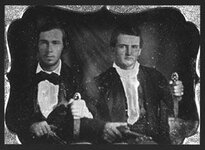michael bergman
Tenderfoot
- Aug 5, 2013
- 8
- 2
- Primary Interest:
- All Treasure Hunting
looking for anyone who has knowledge about bowie knives. and the name (D.F. KERBOW).


this is the bowie knife in question. my great grandmother Mrs. Genevieve Kesir was the daughter of the head of the British consul in Durango Mexico. she gave stories about Poncho villas men trying to take over their home and her stripping this off of one of the men. she had stated that it was a Bowie knife but not much else as for when I was young she was already old. I am not stating that this is the Bowie knife from the Alamo heavens no! I am just wondering if anyone had any information on the tie between kerbow and Alamo knives.
I googled the Bart Moore Bowie, and by golly got some pictures, so even before the magazine article, here are a couple of pictures of Bart Moore's Bowie knife. It is now on display in a museum in Arkansas.
View attachment 844926 And also a color photo. View attachment 844929